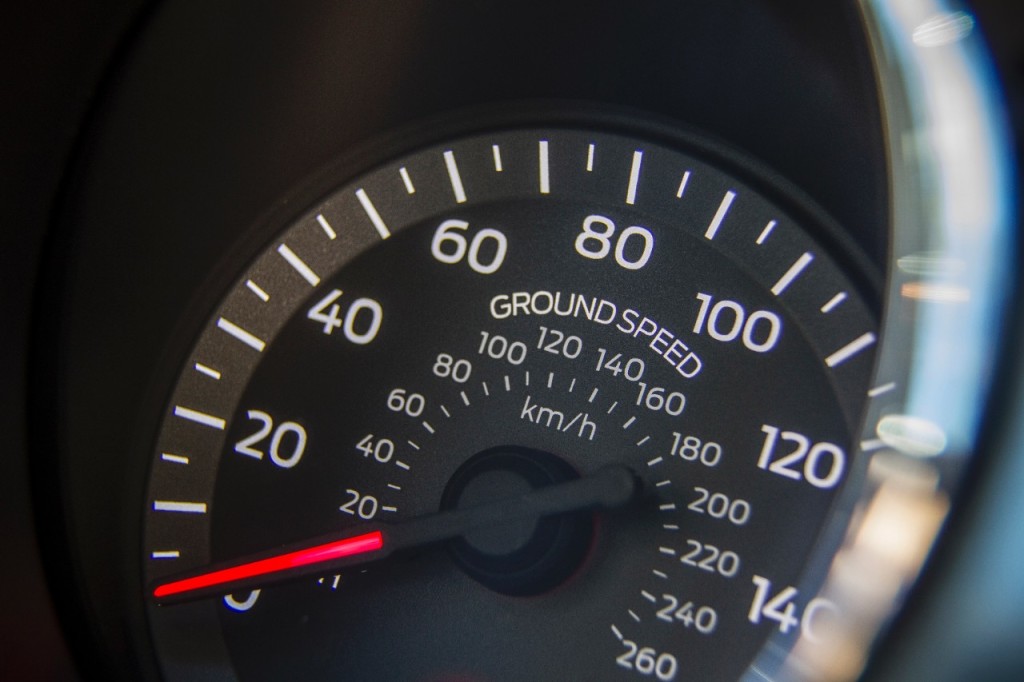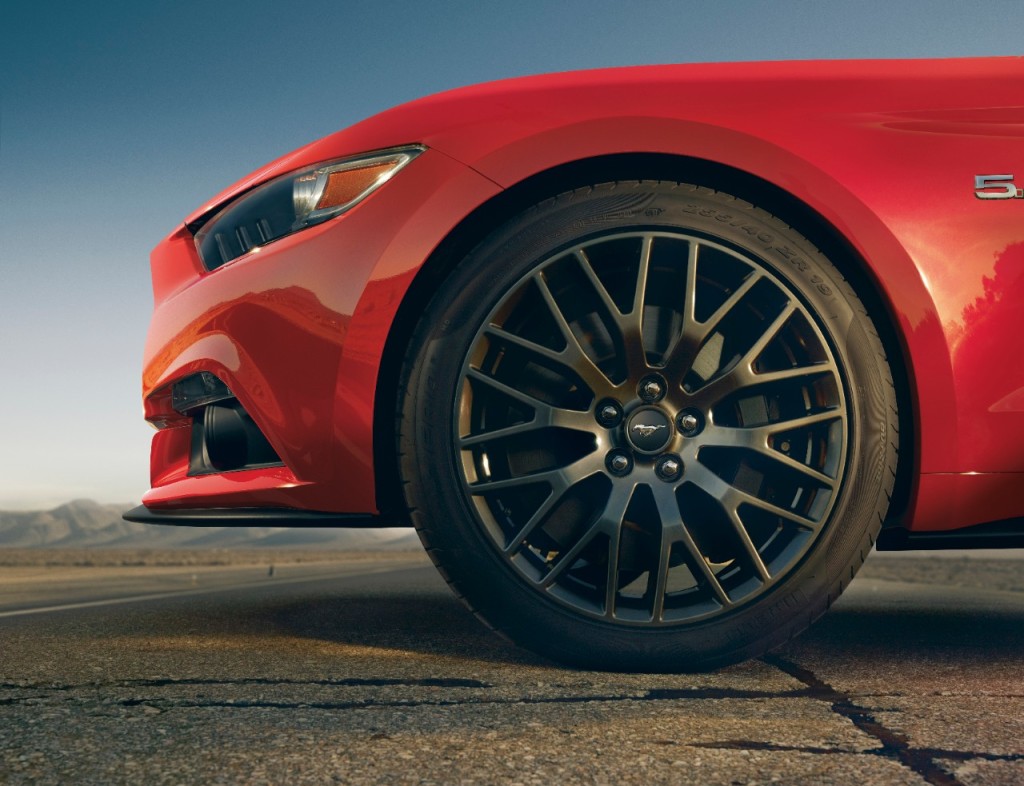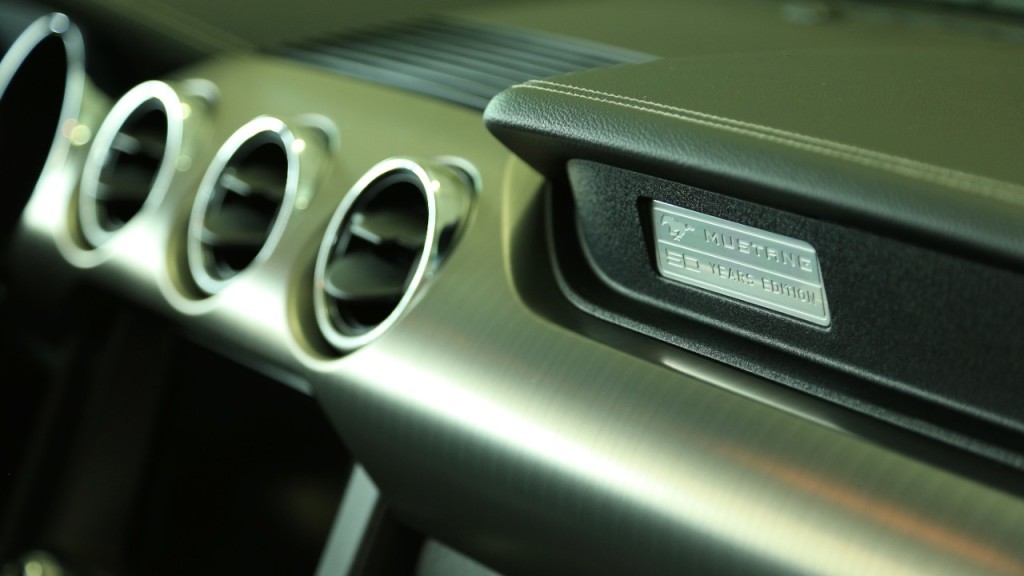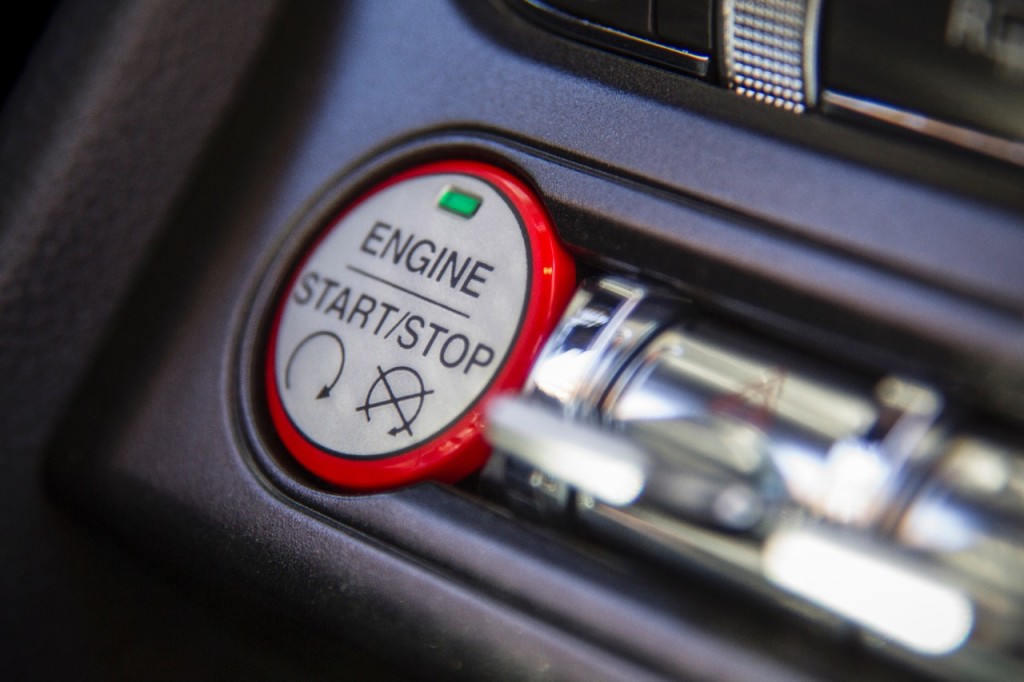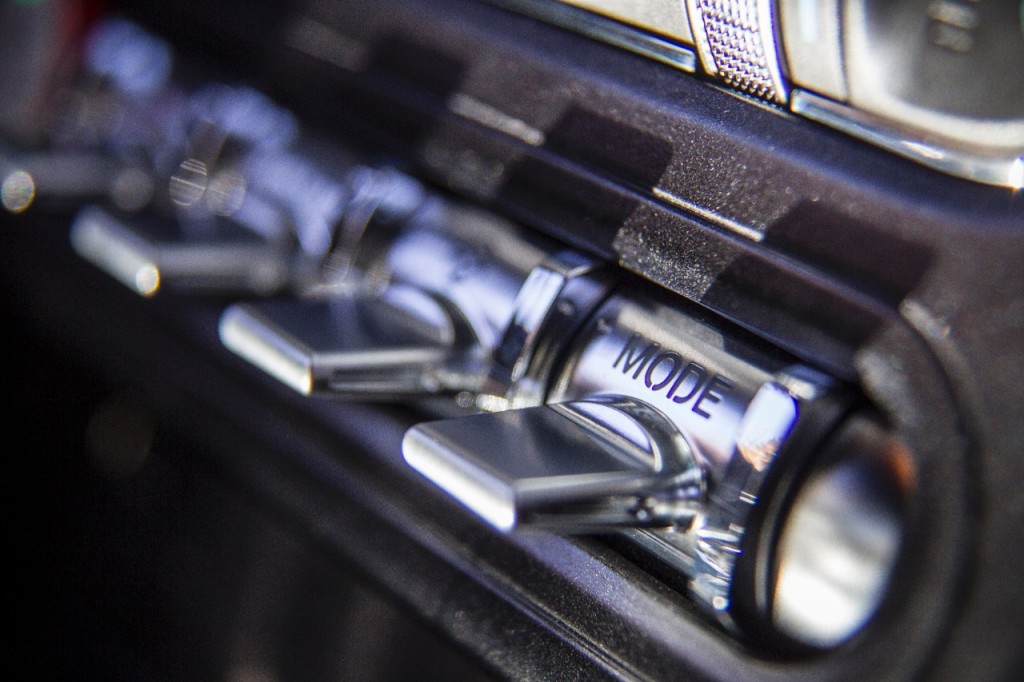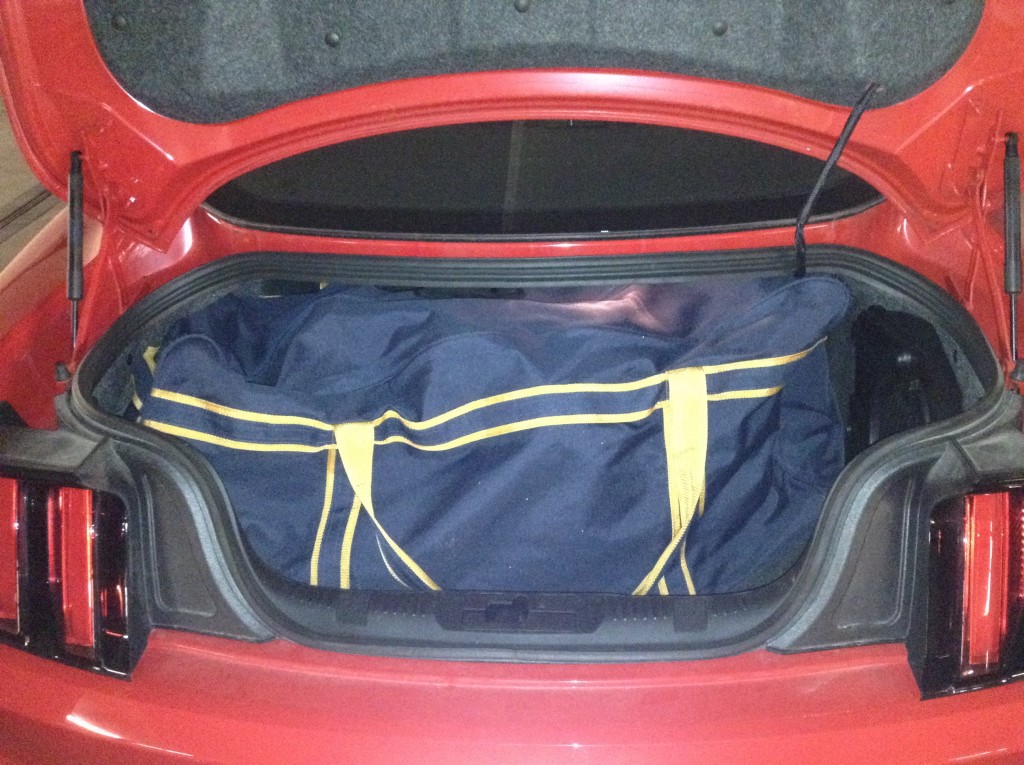Ground Speed. Those are the words on the speedometer of the 2015 Ford Mustang I drove during the week Doc and Marty apparently visited in the second “Back to the Future” movie.
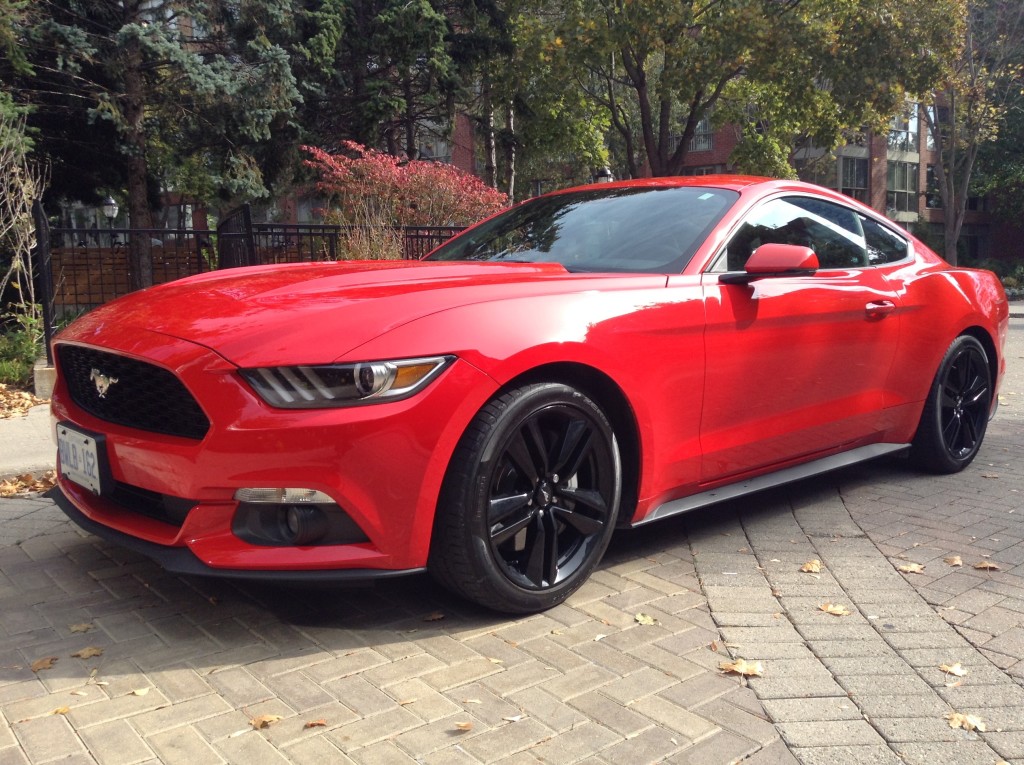
It got me thinking: I really should check out the settings on this car. If it has ground speed, what else might it show? Air speed? Knots? Warp factor?
First impressions
The Mustang is the heavy-looking muscle car that it’s supposed to be: long hood, short deck, shark-front nose, fastback profile, pony car beauty. Straight lines define the sides of this straight shooter, and Ford widened the rear track by 70 millimetres to add an even more aggressive stance.
The EcoBoost performance package on my tester adds 19” painted aluminum wheels and performance tires.
Designers balanced a look that carries on the Mustang tradition with the need to make the car more aerodynamic. Active grille shutters on the 2.3L EcoBoost® model reduce drag at higher speeds when the car doesn’t need extra cooling capacity, even closing the grille completely to send air over and around the car instead of through the engine compartment.
Below the headlights, the Mustang features air vents that lead into the front wheel well. When air flows through this vent, it creates a “curtain” over the wheels, eliminating any drag those lovely wheels would otherwise cause.
Interior
The optional ebony Recaro leather seats aren’t exactly stiff racing shells, but they’re not far off. The side bolsters won’t appeal to overweight Mustang buyers, but they’ll keep driver and passenger in place, no doubt.
The rear seats are just as tight as ever, though one six-foot nephew sat there without complaint, upper body diagonal, behind his inches-taller older brother when I took them for a spin.
Metal-look levers for steering feel, drive mode (including one for wet/snowy weather), hazard lights and traction control are the highlight of this cockpit. Kudos to Ford’s designers for placing them next to the engine start-stop button. These are the switches you go to when you want to determine the car’s driving behaviour.
They look like metal, but feel like… I can’t even write it here. Ford designers need to push back against the beancounters and make sure these levers are made of metal in the future (and maybe sneak in a few more of these switches while they’re at it).
Cargo room
The hockey bag fits without my having to put the back seat down, and the sticks went through the folding rear seats.
The trunk opening could be wider. Ford continues to put taillights on the rear quarter panels instead of moving them to the trunk lid. This one design decision hampers access to the ample trunk when you need that access.
In-car technology
Once I noticed the words “ground speed” I started looking for other settings using the screen in the instrument cluster. Part of me hoped those words were on a screen instead of just being printed onto the speedometer like the numbers. No such luck.
A small screen between the speedometer and tachometer shows the settings determined by the levers at the base of the centre stack, just ahead of the shift knob (see image above). It also provides access to track apps, individual gauges rendered digitally, and a variety of settings that affect the car’s performance. (If you drag race, see the video below for a neat surprise.)
That cluster, and the gauges to the right of the driver, glow white in daylight and burnt orange in lower light. That colour change caught my eye while driving with the sun low in the horizon and long shadows tricking the Mustang’s light sensors into switching colours while I was cruising on the highway.
The 12-speaker Shaker Pro Audio System will help the music compete with the engine on the loudness scale, if you want it to.
Ford’s SYNC ApplLnk is a step up from previous SYNC packages, but I’m looking forward to the day when Ford (and all other carmakers) cede this area of the cabin to the companies that make the smartphones drivers carry with them.
I have yet to try Apple’ CarPlay or Google’s Android Auto, but I can only hope that these systems will provide proper in-car control of third-party apps. To date, I have yet to test a system provided by a carmaker that gets this right.
Driving
My ‘Stang tester ran on Ford’s 2.3L EcoBoost engine. I know what you’re thinking – how could Ford put anything less than a 5L V8 in this car? Let’s just say that the 310 horsepower and 320 lb.-ft. of torque this motor produces won’t leave buyers in anybody’s dust. By Ford’s published numbers, the EcoBoost-powered fastback carries fewer than 11.4 pounds per horsepower, making this (again by Ford’s claims) the best-ever power density from a Ford engine.
A low-inertia twin-scroll turbocharger provides quick response. It starts with a subtle, satisfying growl, and hits the right notes when you accelerate.
If none of this convinces you otherwise, opt for the 5.0-liter V8 (435 horsepower and 400 lb.-ft. of torque).
The six-speed automatic on my tester offered a sport mode so I could go through the gears using steering-wheel-mounted paddle shifters.
Manual-transmission Mustang GTs now ship with standard launch control for drivers who take their rides to the track. Drivers who want to do burnouts before launching will love a feature called Linelock. Ford’s explanation: “With the tires properly warmed up, drivers can pull up to the staging line, engage launch control, and get a perfect catapult as soon as the lights go green.” Check out the video below for details.
https://www.youtube.com/watch?v=O3nbwCjZKk8
Fuel economy
My automatic Fastback boasts 11.0 city / 7.4 hwy / 9.4 combined (all numbers L/100km). These numbers vary slightly by model.
Safety
The full complement of airbags now includes bags that protect the front seat passenger’s knees, as well as side curtains and others you’d expect. The bags and pretensioning belts are triggered by twice as many peripheral crash sensors as there were on the outgoing model.
Ford enhanced the SYNC® 911 Assist® feature. The system already automatically called 911 in the event of a collision; now it can deliver information such as the maximum change in velocity during impact, indication of crash type (front, side, rear or rollover), safety belt usage as detected by the vehicle (remember, buckle up!), awareness of whether multiple impacts occurred and whether airbags were deployed.
Pricing
My tester starts at $33,499 MSRP. Various options, destination and delivery charges brought the price to $47,449, excluding GST/HST.
Conclusion
The looks, the power, the Linelock feature that does away with the need for heel-and-toe or aftermarket modifications, it all adds up to what buyers expect from a Mustang. This pony’s heritage is in good hands.
